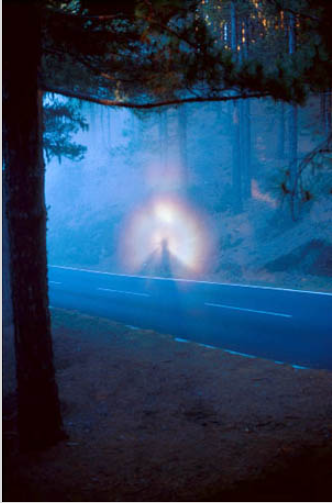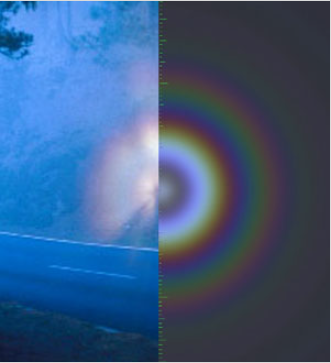Forest glory
Forest Glory: A Captivating Atmospheric Phenomenon
When it comes to atmospheric optics, there are a multitude of captivating phenomena that can occur. One such phenomenon is known as "Forest Glory." In this article, we will delve into the intricacies of this stunning optical display and explore its characteristics and formation.
The Enchanting Mist Droplets
Forest Glory occurs when there is a mist composed of fairly uniform-sized droplets in the air. These mist droplets act as the canvas upon which the glory is painted. The mist creates an ethereal atmosphere, allowing light to interact in fascinating ways and giving rise to this awe-inspiring spectacle.
A Captured Moment of Beauty
In May 2000, Till Credner and Sven Kohle, renowned photographers and atmospheric optics enthusiasts, managed to capture a mesmerizing Forest Glory in a forest on the island of Tenerife. Their photograph also showcased the elusive Brocken shadow, further enhancing the enchantment of the scene.
Correlation and Comparison
What makes this particular photograph even more intriguing is that, in addition to the Forest Glory, Credner and Kohle also managed to photograph a corona in the opposite direction. Both images provide an interesting opportunity for scientific analysis and theoretical validation.
Rings of Wonder
The corona image exhibits several concentric rings, which can be measured and compared to simulations. Through careful analysis, researchers were able to determine that the droplets forming the corona were most likely around 13.5 microns in diameter. This correlation between observation and simulation adds credibility to the scientific understanding of atmospheric optics.
Matching the Glory
While the Forest Glory does not possess as many discernible details for comparison, researchers were able to identify a significant resemblance between the innermost ring and fragments of the next ring of the simulated glory. These findings suggest that the droplets responsible for creating the Forest Glory were likely of a similar size to those forming the corona.
A Simulation of Splendor
To better visualize the formation of the Forest Glory, researchers created an IRIS simulation using droplets with a diameter of 13.5 microns. The simulation, displayed against a black background to emphasize the rings, provides a vivid representation of the intricate patterns and ethereal beauty that can be observed in this atmospheric phenomenon.
Unveiling the Mysteries
The Forest Glory, like many atmospheric optics phenomena, continues to captivate researchers and enthusiasts alike. While we have made significant strides in understanding its formation and characteristics, there is still much to uncover. Further research and exploration will undoubtedly shed more light on the intricacies of this enchanting display.
A Glimpse into Nature's Artistry
Nature never ceases to amaze with its artistic creations, and the Forest Glory is a prime example of its boundless creativity. This optical phenomenon serves as a reminder of the hidden wonders that surround us, waiting to be discovered and appreciated.
Embracing the Beauty
The Forest Glory serves as a gentle reminder for us to pause and marvel at the enchanting beauty that can be found in even the simplest of natural occurrences. Whether it be the misty forests or the captivating play of light, there is always something magical waiting to be witnessed if we take the time to observe and appreciate our surroundings.
Conclusion
Forest Glory, with its ethereal rings and captivating mist droplets, is a mesmerizing atmospheric optics phenomenon. Through careful observation, analysis, and simulation, researchers have been able to unravel some of its mysteries. Yet, the Forest Glory continues to inspire curiosity and wonder, reminding us of the endless enchantment that lies within the natural world. So, next time you find yourself surrounded by misty woods, keep an eye out for the elusive Forest Glory and allow yourself to be immersed in its captivating beauty.

Forest glory Provided there is a mist of fairly uniform sized droplets, glories can be found in many places. Till Credner and Sven Kohle (AlltheSky.com)captured this glory and Brocken shadow in a forest on the island of Tenerife in May 2000.
In the opposite direction they photographed a corona and the two images are an interesting test of theory because the mist droplets forming each were very probably of the same size.
The corona image has several rings which, knowing the image scale, can be well matched to a simulation with 13.5 micron diameter droplets. Does the glory also match? There are fewer details against which to fit but the complete innermost ring and fragments of the next do match those of the simulated glory (right) for the same droplets.
Photo ©Till Credner & Sven Kohle and reproduced with permission.

IRIS simulation for 13.5 micron diameter droplets. The background has been left black to better show the rings.
Note: this article has been automatically converted from the old site and may not appear as intended. You can find the original article here.
Reference Atmospheric Optics
If you use any of the definitions, information, or data presented on Atmospheric Optics, please copy the link or reference below to properly credit us as the reference source. Thank you!
-
<a href="https://atoptics.co.uk/blog/forest-glory/">Forest glory</a>
-
"Forest glory". Atmospheric Optics. Accessed on April 24, 2024. https://atoptics.co.uk/blog/forest-glory/.
-
"Forest glory". Atmospheric Optics, https://atoptics.co.uk/blog/forest-glory/. Accessed 24 April, 2024
-
Forest glory. Atmospheric Optics. Retrieved from https://atoptics.co.uk/blog/forest-glory/.